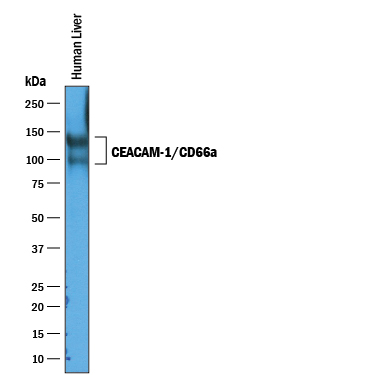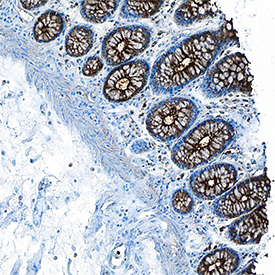Human CEACAM-1/CD66a Antibody Summary
Gln35-Gly428
Accession # P13688
Applications
Please Note: Optimal dilutions should be determined by each laboratory for each application. General Protocols are available in the Technical Information section on our website.
Scientific Data
 View Larger
View Larger
Detection of Human CEACAM‑1/CD66a by Western Blot. Western blot shows lysates of human liver tissue. PVDF membrane was probed with 1 µg/mL of Goat Anti-Human CEACAM-1/CD66a Antigen Affinity-purified Polyclonal Antibody (Catalog # AF2244) followed by HRP-conjugated Anti-Goat IgG Secondary Antibody (Catalog # HAF019). A specific band was detected for CEACAM-1/CD66a at approximately 100-150 kDa (as indicated). This experiment was conducted under reducing conditions and using Immunoblot Buffer Group 1.
 View Larger
View Larger
CEACAM‑1/CD66a in Human Colon Tissue. CEACAM-1/CD66a was detected in immersion fixed paraffin-embedded sections of human colon tissue using Goat Anti-Human CEACAM-1/CD66a Antigen Affinity-purified Polyclonal Antibody (Catalog # AF2244) at 5 µg/mL overnight at 4 °C. Tissue was stained using the Anti-Goat HRP-DAB Cell & Tissue Staining Kit (brown; Catalog # CTS008) and counterstained with hematoxylin (blue). Specific staining was localized to plasma membrane in glandular epithelial cells. View our protocol for Chromogenic IHC Staining of Paraffin-embedded Tissue Sections.
Reconstitution Calculator
Preparation and Storage
- 12 months from date of receipt, -20 to -70 °C as supplied.
- 1 month, 2 to 8 °C under sterile conditions after reconstitution.
- 6 months, -20 to -70 °C under sterile conditions after reconstitution.
Background: CEACAM-1/CD66a
Carcinoembryonic antigen (CEA)-related cell adhesion molecule 1 (CEACAM-1; also BGP) is a 160 kDa member of the CEACAM branch of the CEA gene family of the immunoglobulin superfamily (1‑3). It is one of seven human CEACAM subfamily genes that are essentially divided equally between type I transmembrane proteins (CEACAM-1, 3 & 4) and GPI-linked molecules (CEACAM-5-8). There is no CEACAM-2 in human. The gene for human CEACAM-1 codes for a 526 amino acid (aa) type I transmembrane protein that contains a 34 aa signal sequence, a 394 aa extracellular domain (ECD), a 24 aa transmembrane segment, and a 74 aa cytoplasmic region (4, 5). The ECD contains one N-terminal V-type Ig-like domain, followed by three C2-type Ig-like domains. It shows considerable glycosylation, including high mannose residues and (sialyl) LewisX (1). The cytoplasmic region shows one ITIM motif and a calmodulin binding site (1‑3). In addition to the full length form, ten alternate splice forms have been reported (1, 4, 6, 7, 8). There are three soluble and seven transmembrane isoforms, with variations occurring in both the ECD and cytoplasmic region. All ten alternate splice forms contain the V-type Ig-like domain (aa’s 35‑142). The three soluble forms also contain the first two C2-type Ig-like domains (aa’s 145‑317), with differences coming in the third C2-type Ig-like domain (6). The seven transmembrane isoforms are highly divergent. Five of the seven contain the V-type plus the first two C2-type domains and then diverge considerably both in the ECD and cytoplasmic region. The remaining two contain only the V-type Ig-like domain, the transmembrane region, and either a full‑length or truncated cytoplasmic tail (1, 8). The actual functions of the isoforms are unclear. Full‑length mouse and rat CEACAM-1 are approximately 57% aa identical to human CEACAM-1; in the V-type Ig-like domain, they are 58% and 56% aa identical, respectively. The full‑length molecule is found on neutrophils, bile duct epithelium, activated NK cells, colonic columnar epithelium and endothelium. It is known to act as an intercellular adhesion molecule, forming both homotypic, and heterotypic bonds with CEA and CEACAM-6/NCA (3, 9). On neutrophils, CEACAM-1 also binds to dendritic cell CD-SIGN via its LeX moiety, inducing dendritic cell maturation and a subsequent Th1-type response (10,11).
- Beauchemin, N. et al. (1999) Exp. Cell Res. 252:243.
- Thompson, J. et al. (1992) Genomics 12:761.
- Waggener, C. and S. Ergun (2000) Exp. Cell Res. 261:19.
- Barnett, T.R. et al. (1989) J. Cell Biol. 108:267.
- Hinoda, Y. et al. (1988) Proc. Natl. Acad. Sci. USA 85:6959.
- Kuroki, M. et al. (1991) Biochem. Biophys. Res. Commun. 176:578.
- Barnett, T.R. et al. (1993) Mol. Cell. Biol. 13:1273.
- Watt, S.M. et al. (1994) Blood 84:200.
- Oikawa, S. et al. (1992) Biochem. Biophys. Res. Commun. 186:881.
- Klaas, P.J.M. et al. (2005) FEBS Lett. 579:6159.
- Bogoevska, V. et al. (2005) Glycobiology 16:197.
Product Datasheets
Citations for Human CEACAM-1/CD66a Antibody
R&D Systems personnel manually curate a database that contains references using R&D Systems products. The data collected includes not only links to publications in PubMed, but also provides information about sample types, species, and experimental conditions.
4
Citations: Showing 1 - 4
Filter your results:
Filter by:
-
Prognostic Impact of CEACAM1 in Node-Negative Ovarian Cancer Patients
Authors: L Oliveira-F, R Goswami, V Galatenko, Y Ding, K Eylmann, K Legler, S Kürti, B Schmalfeld, K Milde-Lang
Dis. Markers, 2018-06-28;2018(0):6714287.
Species: Human
Sample Types: Tissue Homogenates
Applications: IHC, Western Blot -
Cytomegalovirus impairs cytotrophoblast-induced lymphangiogenesis and vascular remodeling in an in vivo human placentation model.
Authors: Tabata T, Petitt M, Fang-Hoover J, Rivera J, Nozawa N, Shiboski S, Inoue N, Pereira L
Am J Pathol, 2012-09-07;181(5):1540-59.
Species: Human
Sample Types: Whole Tissue
Applications: IHC-Fr -
Glycosylation-dependent interactions of C-type lectin DC-SIGN with colorectal tumor-associated Lewis glycans impair the function and differentiation of monocyte-derived dendritic cells.
Authors: Nonaka M, Ma BY, Murai R, Nakamura N, Baba M, Kawasaki N, Hodohara K, Asano S, Kawasaki T
J. Immunol., 2008-03-01;180(5):3347-56.
Species: Human
Sample Types: Cell Lysates
Applications: Western Blot -
CEA-related cell adhesion molecule-1 is involved in angiogenic switch in prostate cancer.
Authors: Tilki D, Irmak S, Oliveira-Ferrer L, Hauschild J, Miethe K, Atakaya H, Hammerer P, Friedrich MG, Schuch G, Galalae R, Stief CG, Kilic E, Huland H, Ergun S
Oncogene, 2006-03-27;25(36):4965-74.
Species: Human
Sample Types: Tissue Homogenates
Applications: Western Blot
FAQs
No product specific FAQs exist for this product, however you may
View all Antibody FAQsReviews for Human CEACAM-1/CD66a Antibody
There are currently no reviews for this product. Be the first to review Human CEACAM-1/CD66a Antibody and earn rewards!
Have you used Human CEACAM-1/CD66a Antibody?
Submit a review and receive an Amazon gift card.
$25/€18/£15/$25CAN/¥75 Yuan/¥2500 Yen for a review with an image
$10/€7/£6/$10 CAD/¥70 Yuan/¥1110 Yen for a review without an image


